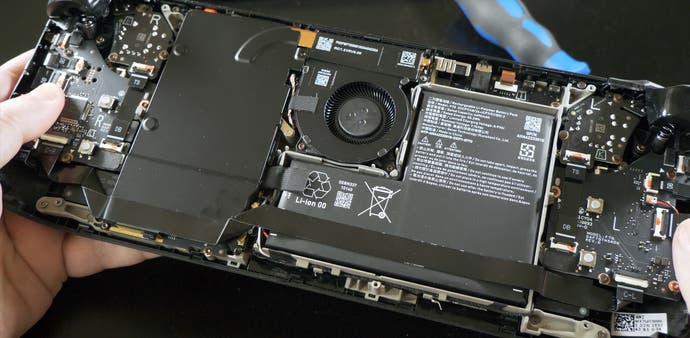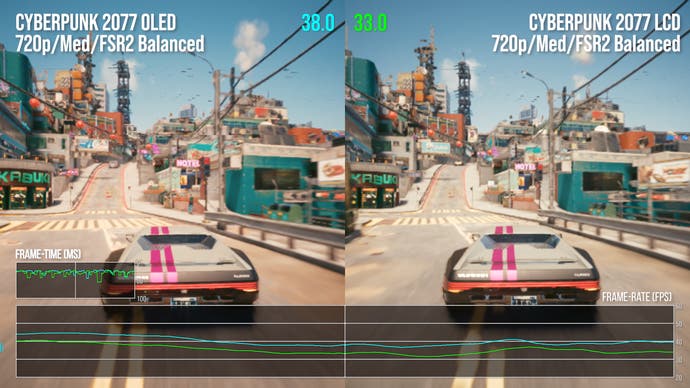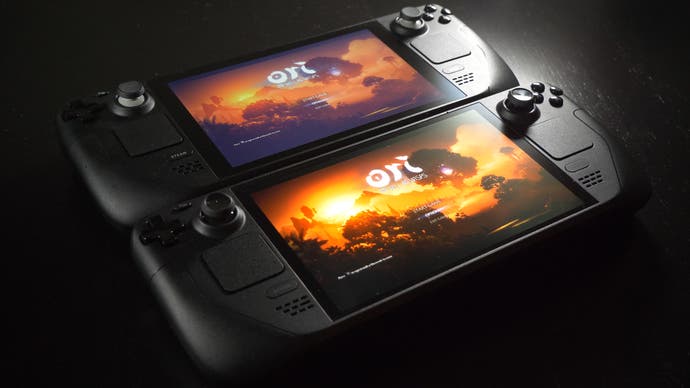Steam Deck OLED review: a beautiful display upgrade - and so much more
Excellent improvements across the board, including much better battery life.
Let's be clear, the brand new Steam Deck OLED isn't just the original machine with a brand new display. Excluding the outer shell, it's essentially a top to bottom revamp of the entire machine and perhaps the most extensive mid-generation 'console refresh' I've seen. But let's give that beautiful new display its due: it's bigger, brighter, runs at 90Hz and in combination with enhancements to SteamOS, you get full HDR support too. Boot up Ori and the Will of the Wisps for some class-leading HDR and you quickly realise that Valve has delivered home cinema display fidelity to a handheld games machine. It's simply stunning.
Side-by-side with the original Deck, the handheld itself looks much the same as the first generation offering but as soon as you power up the unit, you'll see an extraordinary, night and day improvement over the standard model. Valve cites a million to one contrast ratio (par for the course with OLED) along with a 110 percent P3 wide colour gamut and a 90Hz refresh rate. In terms of peak brightness with HDR highlights, the display hits 1000 nits - a huge improvement over the lacklustre 400 nits in the original LCD. The display itself is larger too: 7.4 inches up against the 7-inch screen of the launch machine, which essentially translates into smaller bezels.
The 90Hz refresh is accompanied by tweaks to SteamOS's frame-rate limiting capabilities. On the LCD model, users have control over the target frame-rate as defined by the refresh rate you set on the screen. In the review software I tested, this is reduced to a simple slider: define the frame-rate cap you want, and SteamOS sets up the 90Hz display accordingly. There's still no VRR, but the screen is configurable from 45Hz up to 90Hz. Choose 30fps, for example, and the display still refreshes at 90Hz, repeating the same frame three times. Choose 40fps and the display drops back to 80Hz, doubling every frame - you get the idea.
| System Specifications | Steam Deck | Steam Deck OLED |
|---|---|---|
| Main Processor | Custom AMD 'Van Gogh' 7nm | Revised AMD 'Van Gogh' 6nm |
| Memory | 16GB LPDDR5 5500MT/s | 16GB LPDDR5 6400MT/s |
| Display | 1200x800 - 7-Inch 60Hz IPS, peak 400 nits | 1200x800 - 7.4-Inch 90Hz OLED, wide colour gamut, HDR peak 1000 nits,SDR peak 600 nits |
| Battery | 40WHr | 50WHr |
| Wireless | Dual-band Wi-Fi radio, 2.4GHz and 5GHz, 2x2 MIMO, IEEE 802.11a/b/g/n/ac | Tri-band Wi-Fi 6E radio, 2.4GHz, 5GHz, and 6GHz 2x2 MIMO, IEEE 802.11a/b/g/n/ac/ax |
| Weight | 669g | 639g |
Configuring and enabling HDR can be a bit messy in Windows, but with Valve's control of the operating system on Steam Deck, it's very simple. Some games should automatically boot in HDR mode, while the only thing you need to do on others is to enable HDR in the game's settings menu. Across my favourite games, everything 'just worked' with the minimum of effort and the maximum reward, because the quality of the screen is just that good. I've reviewed many PC handhelds but nothing gets close to this.
The rest of the Steam Deck remains much the same as the original, except that it's cooler, quieter and lighter. There's only a 30g difference between Steam OLED and the launch model, but weirdly, it's very easy to tell the difference and to appreciate it while playing. Acoustics are far less intrusive owing to a larger fan (which can spin less quickly to displace the same amount of heat) along with the introduction of a 6nm process shrink on the custom AMD Van Gogh processor. This chip's more efficient than its 7nm predecessor, meaning reduced power draw and less heat. The end result is that while the new Deck isn't quite in Switch territory in terms of its audio profile, it's noticeably less loud than the launch Steam Deck.
The revised processor is also paired up with 6400MT/s memory, a step up from the 5500MT/s modules found in the original Deck. While Valve says that the performance target of the new Deck is unchanged from the old one, I actually found that the revised model is around two percent to nine percent faster than the original, depending on content. More memory bandwidth (and lower latency, according to Valve) is very, very helpful for AMD APUs and it may well be the case that the extra efficiency on the new processor also extracts a little more performance from the chip, bearing in mind that overall TDP remains at 15W, just like the original.
In practice, this means that if you're setting a frame-rate cap under 60fps, you're getting an extra two to three frames per second - so you're more likely to adhere more doggedly to your chosen limit. Something else I encountered a few times is that the newer Deck appears to stutter less when it's really under load - most noticeable in fast traversal in Cyberpunk 2077 and when first encountering the deluge of rats in A Plague Tale: Requiem.
Valve's Steam Deck refresh sees the engineers touch just about every element of the machine, with a keen eye on improving the user experience every time. The most noticeable aspect of this comes from battery life. The HDR screen is actually more efficient than its LCD predecessor, and we've already discussed the benefits of the new 6nm processor. However, nuking battery life issues from orbit is achieved via a bigger battery - 50WHr in the new Deck vs 40WHr in the old one.
Even without the extra enhancements, you're looking at 25 percent more battery then, but the extra efficiencies elsewhere add a subtle multiplier effect that gets you anything from 30 percent to 50 percent more game time, according to Valve. I chose a static scene in Cyberpunk 2077 to get an idea of how everything compares in a like-for-like scenario and ended up with anything from a circa 42 to 45 percent boost to battery life.

| Cyberpunk 2077 Battery | Steam Deck | Steam Deck OLED |
|---|---|---|
| Unlocked Frame-Rate | 26.1W, 1 hours 32 minutes | 23.0W, 2 hours 12 minutes |
| 30fps Frame-Rate Cap | 21.9W, 1 hours 50 minutes | 18.8W, 2 hours 40 minutes |
Valve's list of additional improvements is too long to list here but the highlights include a WiFi 6E upgrade for a notional 3x improvement to download times, faster charging times, faster resume times from standby, a 180Hz polling rate on the new touchscreen, a new Bluetooth 5.3 module with a dedicated antenna allowing for WiFi and BT to be used simultaneously, while haptics and the trackpad are also improved. Steam Deck's already best-in-class audio is now louder with more bass, with the thumbsticks also receiving subtle improvements. Valve also cites improved repairability with more durable screws with metal bosses, while the display can be swapped out without having to remove the rear of the unit.
All told then, Steam Deck OLED is substantially improved across the board and its arrival also shakes up the range of available options. There's still a $399 entry point, but it's basically a first-gen Deck with a 256GB SSD - an appreciable improvement over the older model with 64GB of eMMC flash but lacking all of the refinements brought about by the OLED model. $549 gets you the new hardware with a 512GB SSD, while $649 endows you with 1TB of storage instead.
Older Decks get price cuts but really, I find all of them hard to recommend with the arrival of the new OLED model. If you've seen the difference between a Switch and Switch OLED, you have some idea of the improvement here, but the high-spec nature of the screen and support for HDR is something else altogether - this is point blank the most impressive handheld screen I've seen. Quality of life improvements via improved battery life, weight reductions and improved acoustics simply add further to the refinement. Unless you're budget-constrained, the OLED model is highly recommended as the default purchase.


Criticisms? Well, I'd have liked to have seen another USB-C port and prospective users also need to accept that we're a long way off from a new Steam Deck arriving - and there's no doubt that some of the more demanding games don't run great with the existing performance level. That said, you'll never be short of titles that do play exceptionally well - and the OLED screen is an excellent reason to revisit some of your library titles. Batman Arkham Knight was my first port of call and I did not come away disappointed.
With competing Windows handhelds delivering more power at the expense of a good user experience and decent battery life, what was arguably the best PC portable money can buy is now much, much better. Valve describes Steam Deck OLED as the definitive first generation model and it's hard to disagree, but that does a disservice to the firm's overall achievements in the handheld space since the original launched in early 2022.
From shaky beginnings, SteamOS itself has evolved into a competent, accessible way to play PC games on the go, successfully carving out an entirely new PC market. With its software, Valve has expertly straddled the line between mainstream accessibility and the kind of customisation and tweakability that the PC audience demands. The Proton compatibility layer rarely intrudes on the experience and some games actually run better under SteamOS than they do on Windows.
Across its lifespan, Steam Deck has outstripped expectations - and with Steam Deck OLED, Valve is set to do it again. This is an exceptional piece of kit.










